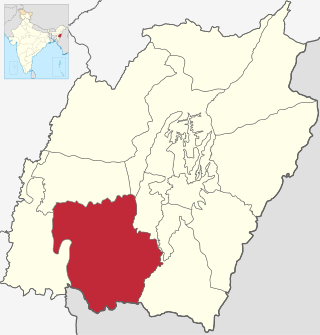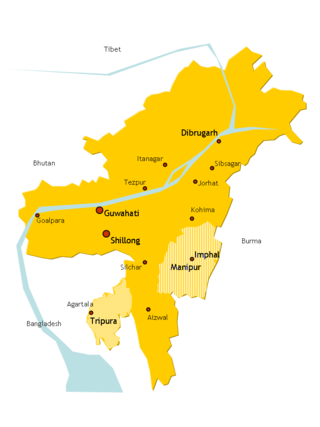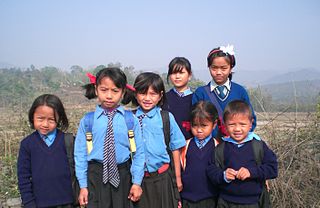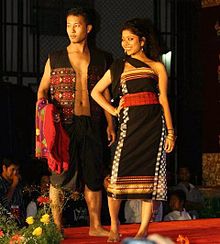
Mizoram is a landlocked state in northeast India, with Aizawl as its seat of government and largest city. Within India's northeast region, it is the southernmost state, sharing borders with three of the Seven Sister States, namely Tripura, Assam and Manipur, and also shares a 722-kilometre (449 mi) border with the neighbouring countries of Bangladesh and Myanmar. The state spans over an area of approximately 21,087 square kilometres, of which approximately 91% is forested. With an estimated population of 1.25 million in 2023, it is the second least populous state in the country.
The Koireng people are one of the ethnic groups inhabiting Manipur in North-East India. They speak the [Koireng language]. They are mentioned in the Meitei royal chronicle Cheitharol Kumbaba in the year 1404, one of the oldest tribes to be so mentioned. They have a shared common ancestry, history, cultural traits, folklore and dialects with their kindred people like Aimol and Kom. They use Meitei language as their second language (L2) according to the Ethnologue.

The Mizo people, historically recorded as the Lushais, are an ethnic group native to the state of Mizoram in India and neighbouring states of Northeast India. They speak the Tibeto-Burman language of Mizo, the official language and lingua franca of Mizoram. The state is the second most literate state in India, at more than a rate of 90%.

Churachandpur District, is one of the 16 districts of the Indian state of Manipur populated mainly by Kuki-Zo people. The name honours former Maharaja Sir Churachand Singh of Manipur. The district headquarters is located in the Churachandpur town, which is also locally known by the name Lamka.
The Paite people are an ethnic group in Northeast India, mainly living in Manipur and Mizoram. The Paites are recognized as a scheduled tribe in these two states. They are part of the Kuki-Zo people, but prefer to use the Zomi identity. "Guite" is a major clan of the Paite people.

The history of Mizoram encompasses the history of Mizoram which lies in the southernmost part of northeast India. It is a conglomerate history of several ethnic groups of Chin people who migrated from Chin State of Burma. But information of their patterns of westward migration are based on oral history and archaeological inferences, hence nothing definite can be said. The recorded history started relatively recently around the mid-19th century when the adjoining regions were occupied by the British monarchy. Following religious, political and cultural revolutions in the mid-20th century majority of the people agglomerated into a super tribe, Mizo. Hence the officially recognised settlement of the Mizos became Mizoram.

The Kuki people are an ethnic group in the Northeastern Indian states of Manipur, Nagaland, Assam, Meghalaya, Tripura and Mizoram, as well as the neighbouring countries of Bangladesh and Myanmar. The Kukis form one of the largest hill tribe communities in Northeast India, along with the adjoining regions of Bangladesh and Myanmar. In Northeast India, they are present in all states except Arunachal Pradesh. The Chin people of Myanmar and the Mizo people of Mizoram are kindred tribes of the Kukis. Collectively, they are termed the Zo people.

Bishnupur district or Bishenpur district, is a district of Manipur state in northeastern India.

Chandel district is one of the 16 districts of Manipur state in northeastern India. Its headquarters is the town of Chandel. In December 2016, a part of the district was split to establish the new Tengnoupal district. The district is mainly populated by Kuki-Zo and Old Kuki/Naga tribal people.

Senapati, is one of the 16 districts of the Indian state of Manipur. The present Senapati district was formed in December 2016, after spawning off the Sadar Hills region in the south into a separate Kangpokpi district. The district headquarter is located in the municipality of Tahamzam.

Ukhrul district is an administrative district of the state of Manipur in India with its headquarters at Ukhrul. The Ukhrul district has a long history dating back to the 1920s when it was created as the North-East Hill Sub-Division of the then princely state of Manipur. In 2016, the Kamjong subdivision of the Ukhrul district was spun out as a separate district, leading to the present configuration of the Ukhrul district.

Kalewa is a town at the confluence of the Chindwin River and the Myittha River in Kale District, Sagaing Region of north-western Myanmar. It is the administrative seat of Kalewa Township.
Guite is the progenitor clan of Zomi people, also called Chin in Myanmar, Mizo, or Paite, or even Kuki in India. According to Zam, Nigui Guite is the elder brother of the ancestral fathers of the Thadou people, namely Thangpi, Sattawng, and Neirawng. This genealogy was recently inscribed on the tribal memorial stone at Bungmual, Lamka in the presence of each family-head of the three major clans, Doungel, Kipgen, and Haokip, on August 7, 2011. Some historians, like Shakespeare, assumed Lamlei was the Nigui Guite himself but the Guites themselves recounted Tuahciang, the father of Lamlei, as the son of Nigui Guite instead, in their social-religious rites. Regarding Guite as the born son of Songthu and his sister, Nemnep, it was the practice of ancient royalty to issue royal heir and also to keep their bloodline pure instead. Depending on local pronunciation, the clan was also called by different names such as Nguite or Vuite, Gwite, Nwite, Paihte by the Lushei. In accord with the claim of their solar origin, the Guite clan has been called nampi, meaning noble or major or even dominant people, of the region in local dialect in the past.
The Lai people mainly inhabit the southern parts of Chin Hills in Myanmar's Chin State, in the townships of Falam, Thantlang and Hakha. They are also found in the Lawngtlai district of Mizoram, India, where they have been granted the Lai Autonomous District Council. Outside this area they are scattered in Mizoram and in Manipur. Their languages "Laizo Lai" and "Hakha Lai" are classified as Central Kuki-Chin languages.

The Khelma, also known as the Sakachep are one of the Old Kuki tribes of northeastern parts of India.

The Bom, Bawm or Bawmzo, are an ethnic community inhabiting the Chittagong Hill Tracts of Bangladesh. According to the 2022 Bangladeshi census the population of Bawms in Bangladesh is 13,193. In 2004, around 10,000 Bawm inhabited India. 2,500 Bawms reside in Myanmar. They speak the Sino-Tibetan Bawm language.

The Biates are an ethnic hill tribe of Assam, Meghalaya, Mizoram, Tripura and Manipur. Their language belongs to the Tibeto-Burman family. Spread over many parts of North-East India, they have a unique identity with a rich and distinctive history, culture, dialect and religious heritages. They are one of the oldest hill tribes of North East India especially among the Chin-Kuki-Mizo people. The term Biate comes from the word Bia-te. The word ‘Bia’ or ‘Biak’ means ‘speak’ or ‘worship’. ‘Te’ is a suffix denoting plurality. Hence, the two words combine to form the word Biate, which means worshipper.
Ranglong is an ethnic people belonging to the Kuki people. The majority of the Ranglong people live in a small and densely-packed area in the northeastern part of India, mainly in the border areas of Tripura, Assam and Mizoram.

The Neihsial is an ethnic group found in northeastern India and parts of Myanmar. Members of this group are largely concentrated in the Churachandpur, Senapati, Chandel District and Tamenglong district of the Indian state of Manipur. There is also a sizable population in the neighboring Chin State of Myanmar.

The hill tribes of Northeast India are hill people, mostly classified as Scheduled Tribes (STs), who live in the Northeast India region. This region has the largest proportion of scheduled tribes in the country.
















